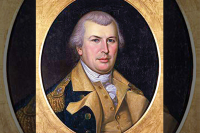Another look at Wolfe
Thomas Wolfe: An Illustrated Biography by Ted Mitchell. Pegasus Books, 2007. 341 pages.
Thirty-three years ago this month, at the dreg-ends of an evil winter and a harsh spring, I went to the library at the University of Connecticut and obtained a copy of Look Homeward, Angel. My personal life had become a mess, I felt lost and alone in New England, and I looked for a touch of home in Thomas Wolfe’s first novel.
Having consumed this book, I read everything else by him I could get my hands on — the other three novels, some short stories, a collection of letters. I read the biography by Elizabeth Nowell. Later I reread Look Homeward while making my way through the work of Fitzgerald and Hemingway, John Gardner and Larry Woiwode, and dozens of other writers old and new. For the next three years I ransacked libraries wherever I lived, deepening my reading, broadening it to include the Russians and the English writers, the poets and novelists I’d missed during the six years of formal education following high school.
It was Thomas Wolfe who set me off on this hunt, and though I became more a reader than a writer, I see now I owe him an enormous debt in terms of my life and what I have made of it.
Fine writers from Jack Kerouac to Pat Conroy, from William Styron to James Jones, from Ray Bradbury to Norman Mailer have all spoken of the debt they owe to Wolfe, of what he meant to their own writing lives in terms of inspiration. As a young man, I, too, found in Wolfe a sense of myself, a feeling of possibility that hadn’t existed in me before. He made me feel the romance of the world, the adventure of being young, the excitement of simply being alive.
Related Items
Ted Mitchell’s Thomas Wolfe: An Illustrated Biography (Pegasus Books, ISBN 1-933648-10-4, $22) reminded me of how much Wolfe meant to me then, and why he meant so much to so many writers who came after him. Mitchell, an employee of the Thomas Wolfe Memorial here in Asheville and the author of five books on Wolfe, issued this most recent reminder of Wolfe’s greatness by carefully editing and then linking chronologically Wolfe’s own writings — his novels, his stories, his letters — with the reviews, letters, and opinions of him by others. This technique of splicing together an author’s life in this way can sometimes fail to get across the author himself — some of the biographical material on Jack Kerouac, for example, tells us more about those who remember him than about Kerouac himself — but Mitchell’s work here strikes me as a valuable, even a brilliant, addition to the Wolfe canon.
Mitchell’s inclusion of so much “illustrated” material — photographs, maps of Asheville, letters, book covers — adds much to this approach and may change the opinions of those of us who know Wolfe largely through his books. If we read Look Homeward, Angel, for example, and fall under Wolfe’s spell, we walk away convinced that he had a miserable and near-impoverished childhood. Here we see that Julia, Wolfe’s mother, was as parsimonious and even stingy as he so frequently portrayed her. We also see a mother who took her son on frequent trips (mentioned in Look Homeward), including a visit to Washington, D.C., for President Wilson’s inauguration in 1913. We see a mother who paid for her son’s schooling under Wolfe’s beloved teacher, Margaret Roberts, and then sent the young Wolfe off for higher education at the University of North Carolina in an era when only a small percentage of Americans graduated from high school, much less college.
Here, too, we can also understand why Wolfe felt so tormented both by his relationship with his editor, Maxwell Perkins, and by literary critics. Particularly illuminating is Bernard DeVoto’s review of Wolfe’s The Story of a Novel alongside Wolfe’s response to that review. In his review, Devoto writes that “so honest or so exhaustive an effort at self-analysis in the interest of esthetics has seldom been made in the history of literature,” but then lays the book aside to attack Wolfe for his methods of composition. DeVoto’s main point was that Wolfe was an immature writer without an ability to edit his own work, and was dependent on “Mr. Perkins and the assembly line at Scribner’s” to help him. This is a common criticism, and not an unjust one entirely, but Wolfe justly tells a friend in a letter that he wished DeVoto had reviewed the book rather than issuing a “general denunciation of all my deficiencies as a writer.”
Many of the authors influenced by Wolfe as teenagers later go on to say that they find his prose creaky and old-fashioned when they return to him at middle age. But writers and reviewers say the same thing about Hemingway, about Dos Passos and Sinclair Lewis, about Fitzgerald (with the possible exception of Gatsby). Recently I reread The Catcher in the Rye, and though I still loved the prose style, Holden Caulfield and his carping about phonies became annoying after only a few pages. Perhaps all fiction annoys as we mature. Perhaps we prefer, as Thomas Wolfe himself did as he grew older, reading almanacs and hard figures at the end of a day.
For the present, Wolfe’s stock is down somewhat. He is not read in high school courses in his own native state because of the length of his books, Few university English departments devote a course to him. Yet his books remain in print, a fact that lacking the support of the academy with its list of required reading, seems to bode well for Wolfe’s reputation and for his future readers. And though I may never reread all of Thomas Wolfe — I teach Look Homeward to my AP students — my aging self can still be wooed and won by his words:
The seed of our destruction will blossom in the desert, the alexin of our cure grows by a mountain rock, and our lives are haunted by a Georgia slattern, because a London cutpurse went unhung. Each moment is the fruit of forty thousand years. The minute-winning days, like flies, buzz home to death, and every moment is a window on time.









